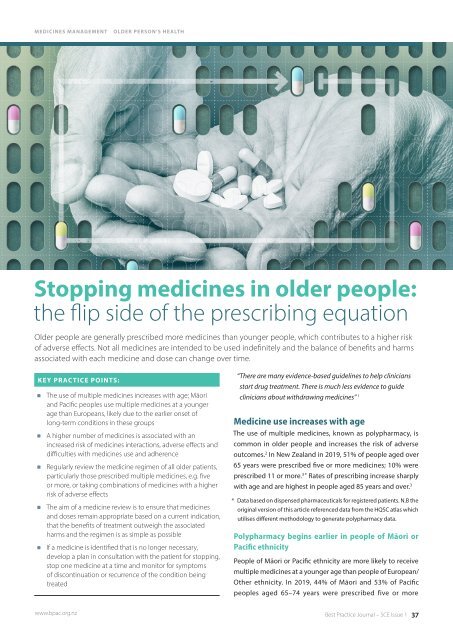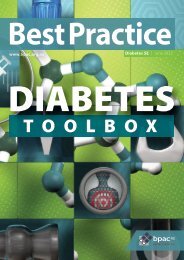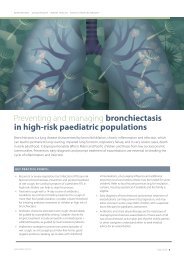You also want an ePaper? Increase the reach of your titles
YUMPU automatically turns print PDFs into web optimized ePapers that Google loves.
MEDICINES MANAGEMENT<br />
OLDER PERSON’S HEALTH<br />
Stopping medicines in older people:<br />
the flip side of the prescribing equation<br />
Older people are generally prescribed more medicines than younger people, which contributes to a higher risk<br />
of adverse effects. Not all medicines are intended to be used indefinitely and the balance of benefits and harms<br />
associated with each medicine and dose can change over time.<br />
KEY PRACTICE POINTS:<br />
The use of multiple medicines increases with age; Māori<br />
and Pacific peoples use multiple medicines at a younger<br />
age than Europeans, likely due to the earlier onset of<br />
long-term conditions in these groups<br />
A higher number of medicines is associated with an<br />
increased risk of medicines interactions, adverse effects and<br />
difficulties with medicines use and adherence<br />
Regularly review the medicine regimen of all older patients,<br />
particularly those prescribed multiple medicines, e.g. five<br />
or more, or taking combinations of medicines with a higher<br />
risk of adverse effects<br />
The aim of a medicine review is to ensure that medicines<br />
and doses remain appropriate based on a current indication,<br />
that the benefits of treatment outweigh the associated<br />
harms and the regimen is as simple as possible<br />
If a medicine is identified that is no longer necessary,<br />
develop a plan in consultation with the patient for stopping,<br />
stop one medicine at a time and monitor for symptoms<br />
of discontinuation or recurrence of the condition being<br />
treated<br />
“There are many evidence-based guidelines to help clinicians<br />
start drug treatment. There is much less evidence to guide<br />
clinicians about withdrawing medicines” 1<br />
Medicine use increases with age<br />
The use of multiple medicines, known as polypharmacy, is<br />
common in older people and increases the risk of adverse<br />
outcomes. 2 In New Zealand in 2019, 51% of people aged over<br />
65 years were prescribed five or more medicines; 10% were<br />
prescribed 11 or more. 3 * Rates of prescribing increase sharply<br />
with age and are highest in people aged 85 years and over. 3<br />
* Data based on dispensed pharmaceuticals for registered patients. N.B the<br />
original version of this article referenced data from the HQSC atlas which<br />
utilises different methodology to generate polypharmacy data.<br />
Polypharmacy begins earlier in people of Māori or<br />
Pacific ethnicity<br />
People of Māori or Pacific ethnicity are more likely to receive<br />
multiple medicines at a younger age than people of European/<br />
Other ethnicity. In 2019, 44% of Māori and 53% of Pacific<br />
peoples aged 65–74 years were prescribed five or more<br />
www.bpac.org.nz<br />
Best Practice Journal – SCE Issue 1 37









